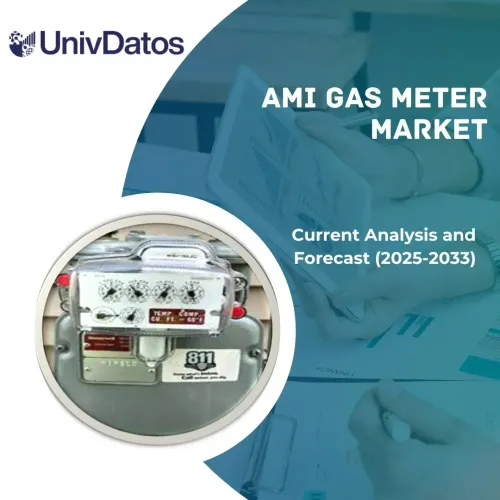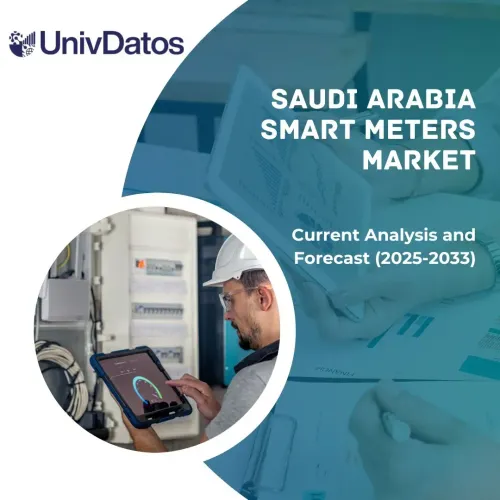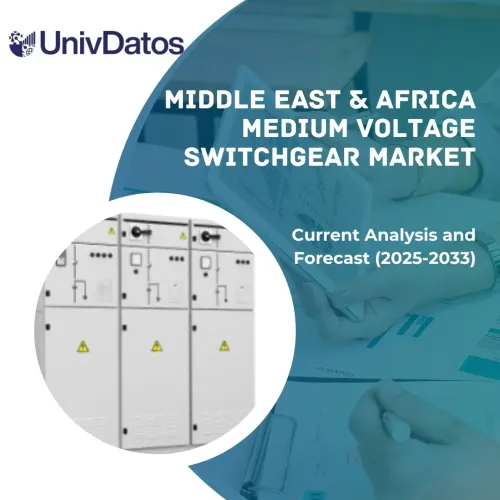- Home
- About Us
- Industry
- Services
- Reading
- Contact Us
Virtual Power Plant Market: Current Analysis and Forecast (2021-2027)
Emphasis on Technology (Distribution Generation, Demand Response, Mixed Asset); End-Use (Commercial, Industrial, Residential); Region and Country
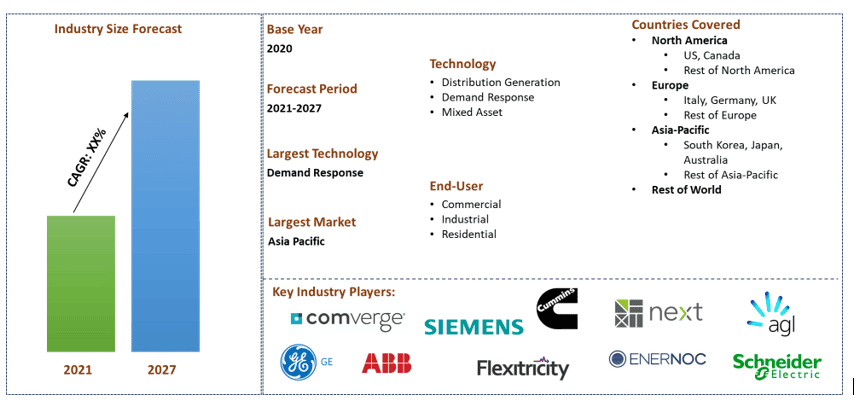
Virtual Power Plant Market is expected to exceed the market valuation of more than US$ 4.7 billion in 2027 and is expected to grow at a significant CAGR of 34% during the forecast period (2021-2027). Renewable Energy is penetrating the market and thus more and more consumers are adopting the distributed energy resources (DER). Electricity providers are adopting virtual power plants (VPPs) which help balance renewable generation variability and supply grid resources. VPPs or VPSs are also known as “the internet of energy”. With the help of VPP, elements from all the different renewable sources can be accumulated at one single central control center i.e., VPP. Currently, the biggest VPP is running in Europe by the Norwegian company Statkraft, and the plant is based in Germany. The output generated by this VPP is over 10,000 MW coming from around 1,400 independent power producers. This includes 1,300 wind farms, 100 solar units as well as bioenergy and hydropower generators.
Key factors influencing the market growth are increasing energy demand in emerging countries like China, India, Japan, and Australia. Due to this they are facing demand-supply issues owing to economic growth and urbanization in the regions. Additionally, with the government policies world over promoting the use of renewable sources, there is an increasing demand for renewable energy as well. For example, in South Korea in 2018 the renewable energy share accounted for only 8% of the total power generated. The South Korean government recently issued a policy to increase the renewable energy mix to 20% by the end of next decade. All countries experimenting with their needs in renewable energy are promoting the use of Virtual power plants as well for the easy transmission of this energy.
Functions of a Virtual Power Plant

Schneider Electric, Engie, Siemens AG, Enel S.p.A., General Electric Company, Royal Dutch Shell Plc, AGL Energy Limited, Flexitricity Limited, Generac Holding Inc., ABB Ltd. are some of the prominent players operating in the Virtual Power Plant market. Several M&As along with partnerships have been undertaken by these players to facilitate customers with hi-tech and innovative products/technologies.
Insights Presented in the Report
“Amongst Technology, Mixed Asset segment holds the major share”
Based on technology, the virtual power plants market is segmented into Distribution Generation, Demand Response, and Mixed Asset. Amongst technology, the mixed asset segment of the virtual power plants market was valued at US$ XX billion in 2020 and is likely to reach US$ XX billion by 2027 and is growing at a CAGR of XX% from 2021-2027. This is due to increasing behind the meter (BTM) and front of the meter (FTM) devices are growing which positively influence distributed energy resources (DER) owners to achieve the greatest possible profits and increase savings on utility bills coupled with maintaining the proper balance of the electricity grid at the lowest possible environmental and economic cost.
“Amongst End-User, Residential Segment holds the major share”
Based on end-user, the virtual power plant market is segmented into Commercial, Industrial, and Residential. Amongst end-user, the residential segment accounted for a market valuation of US$ XX billion in 2020 and is expected to reach US$ XX billion by the year 2027, at a CAGR of XX% over the analyzed period. Increasing penetration of DER in residential complexes like rooftop solar in countries like Australia and Germany are some of the key factors.
“Europe represents one of the largest markets of Virtual Power Plant market”
For a better understanding of the market dynamics of the Virtual Power Plant market, a detailed analysis was conducted for different regions across the globe including North America (the U.S, Canada, and the Rest of North America), Europe (Germany, Italy, United Kingdom, and Rest of Europe), Asia-Pacific (South Korea, Japan, Australia, and Rest of APAC) and Rest of the World. Asia Pacific saw the highest CAGR of XX% in the forecast period due to the increasing demand for electricity in rural areas and thus more renewable energy generation.
Reasons to buy this report:
- The study includes market sizing and forecasting analysis validated by authenticated key industry experts
- The report presents a quick review of overall industry performance at one glance
- The report covers an in-depth analysis of prominent industry peers with a primary focus on key business financials, product portfolio, expansion strategies, and recent developments
- Detailed examination of drivers, restraints, key trends, and opportunities prevailing in the industry
- The study comprehensively covers the market across different segments
- Deep dive regional level analysis of the industry
Customization Options:
Virtual Power Plant market can further be customized as per the requirement or any other market segment. Besides this, UMI understands that you may have your own business needs, hence feel free to connect with us to get a report that completely suits your requirements.
Table of Content
Analyzing the historical market, estimation of the current market, and forecasting the future market of the Virtual Power Plant market were the three major steps undertaken to create and analyze the adoption of Virtual Power Plant in major regions globally. Exhaustive secondary research was conducted to collect the historical market numbers and estimate the current market size. Secondly, to validate these insights, numerous findings and assumptions were taken into consideration. Moreover, exhaustive primary interviews were also conducted, with industry experts across the value chain of the Virtual Power Plant market. Post assumption and validation of market numbers through primary interviews, we employed a top-down/bottom-up approach to forecasting the complete market size. Thereafter, market breakdown and data triangulation methods were adopted to estimate and analyze the market size of segments and sub-segments the industry pertains to. Detailed methodology is explained below:
Analysis of Historical Market Size
Step 1: In-Depth Study of Secondary Sources:
Detail secondary study was conducted to obtain the historical market size of the Virtual Power Plant through company internal sources such as annual report & financial statements, performance presentations, press releases, etc., and external sources including journals, news & articles, government publications, competitor publications, sector reports, third-party database, and other credible publications.
Step 2: Market Segmentation:
After obtaining the historical market size of the Virtual Power Plant market, we conducted a detailed secondary analysis to gather historical market insights and share for different segments & sub-segments for major regions. Major segments included in the report as technology, end-user. Further country-level analyses were conducted to evaluate the overall adoption of renewable energy in that region.
Step 3: Factor Analysis:
After acquiring the historical market size of different segments and sub-segments, we conducted a detailed factor analysis to estimate the current market size of Virtual Power Plant. Further, we conducted factor analysis using dependent and independent variables such as increasing adoption of renewable sources and power instability in DERs. A thorough analysis was conducted for demand and supply-side scenarios considering top partnerships, merger and acquisition, business expansion, and product launches in the Virtual Power Plant sector across the globe.
Seek More Details About Research Methodology
Current Market Size Estimate & Forecast
Current Market Sizing: Based on actionable insights from the above 3 steps, we arrived at the current market size, key players in the Virtual Power Plant market, and market shares of the segments. All the required percentage shares split, and market breakdowns were determined using the above-mentioned secondary approach and were verified through primary interviews.
Estimation & Forecasting: For market estimation and forecast, weights were assigned to different factors including drivers & trends, restraints, and opportunities available for the stakeholders. After analyzing these factors, relevant forecasting techniques i.e., top-down/bottom-up approach was applied to arrive at the market forecast about 2027 for different segments and subsegments across the major markets globally. The research methodology adopted to estimate the market size encompasses:
- The industry’s market size, in terms of value (US$) and the adoption rate of Virtual Power Plant across the major markets domestically
- All percentage shares, splits, and breakdowns of market segments and sub-segments
- Key players in the Virtual Power Plant market in terms of products offered. Also, the growth strategies adopted by these players to compete in the fast-growing market
Market Size and Share Validation
Primary Research: In-depth interviews were conducted with the Key Opinion Leaders (KOLs) including Top Level Executives (CXO/VPs, Sales Head, Marketing Head, Operational Head, and Regional Head, Country Head, etc.) across major regions. Primary research findings were then summarized, and statistical analysis was performed to prove the stated hypothesis. Inputs from primary research were consolidated with secondary findings, hence turning information into actionable insights.
Split of Primary Participants in Different Regions
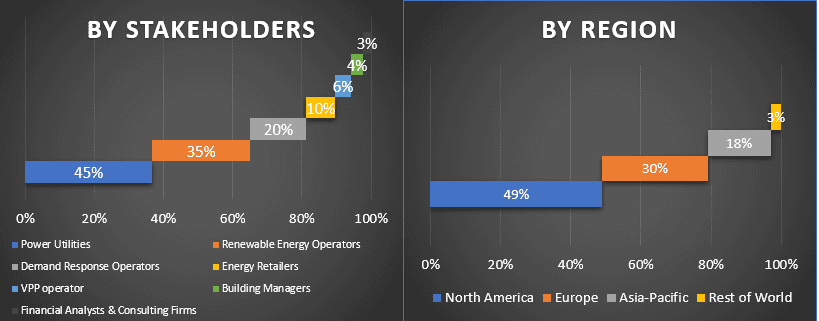
Market Engineering
Data triangulation technique was employed to complete the overall market estimation and to arrive at precise statistical numbers of each segment and sub-segment of the Virtual Power Plant market. Data was split into several segments & sub-segments post studying various parameters and trends in the areas of type and their type of the Virtual Power Plant market.
The main objective of the Virtual Power Plant Market Study
The current & future market trends of Virtual Power Plant were pinpointed in the study. Investors can gain strategic insights to base their discretion for investments from the qualitative and quantitative analysis performed in the study. Current and future market trends were determined the overall attractiveness of the market at a regional level, providing a platform for the industrial participant to exploit the untapped market to benefit as a first-mover advantage. Other quantitative goals of the studies include:
- Analyze the current and forecast market size of Virtual Power Plant in terms of value (US$). Also, analyze the current and forecast market size of different segments and sub-segments
- Segments in the study include areas of type and their subtypes
- Define and analysis of the regulatory framework for the Virtual Power Plant industry
- Analyze the value chain involved with the presence of various intermediaries, along with analyzing customer and competitor behaviors of the industry
- Analyze the current and forecast market size of the Virtual Power Plant market for the major region
- Major regions studied in the report include North America (the U.S, Canada, and Rest of North America), Europe (Germany, United Kingdom, Italy, and Rest of Europe), Asia-Pacific (South Korea, Japan, Australia, Rest of Asia-Pacific), and the Rest of the World
- Company profiles of the Virtual Power Plant market and the growth strategies adopted by the market players to sustain in the fast-growing market
- Deep dive regional level analysis of the industry
Related Reports
Customers who bought this item also bought

